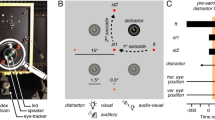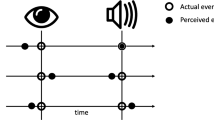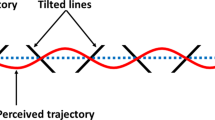Abstract
When voluntary saccadic eye movements are made to a silently ticking clock, observers sometimes think that the second hand takes longer than normal to move to its next position1. For a short period, the clock appears to have stopped (chronostasis). Here we show that the illusion occurs because the brain extends the percept of the saccadic target backwards in time to just before the onset of the saccade. This occurs every time we move the eyes but it is only perceived when an external time reference alerts us to the phenomenon. The illusion does not seem to depend on the shift of spatial attention that accompanies the saccade. However, if the target is moved unpredictably during the saccade, breaking perception of the target's spatial continuity, then the illusion disappears. We suggest that temporal extension of the target's percept is one of the mechanisms that ‘fill in’ the perceptual ‘gap’ during saccadic suppression. The effect is critically linked to perceptual mechanisms that identify a target's spatial stability.
This is a preview of subscription content, access via your institution
Access options
Subscribe to this journal
Receive 51 print issues and online access
$199.00 per year
only $3.90 per issue
Buy this article
- Purchase on Springer Link
- Instant access to full article PDF
Prices may be subject to local taxes which are calculated during checkout



Similar content being viewed by others
References
Brown, P. & Rothwell, J. C. Illusions of time. Soc. Neurosci. Abstr. 27th Annu. Meet. 23, 1119 (1997).
Deubel, H., Irwin, D. E. & Schneider, W. X. in Current Oculomotor Research: Physiological and Psychological Aspects (eds Becker, W., Deubel, H. & Mergner, T.) 65–70 (Plenum, New York, 1999).
Volkmann, F. C. & Moore, R. K. in Visual Psychophysics and Physiology (eds Armington, J. C., Krauskopf, J. & Wooten, B. R.) 353–361 (Academic, New York, 1978).
Ross, J., Concetta Morrone, M., Goldberg, M. E. & Burr, D. C. Changes in visual perception at the time of saccades. Trends Neurosci. 24, 113–121 (2001).
Rizzolatti, G., Riggio, L. & Sheliga, B. M. in Attention and Performance 15: Conscious and Nonconscious Information Processing (eds Umiltà, C. & Moscovitch, M.) 232–265 (MIT Press, Cambridge, Massachusetts, 1994).
Posner, M. I. Orienting of attention. Q. J. Exp. Psychol. 32, 3–25 (1980).
Mack, A. An investigation of the relationship between eye and retinal image movement in the perception of movement. Percept. Psychophys. 8, 291–298 (1970).
Prablanc, C. & Martin, O. Automatic control during hand reaching at undetected two-dimensional target displacements. J. Neurophysiol. 67, 455–469 (1992).
Bridgeman, B., Van der Heijden, A. H. C. & Velichkovsky, B. M. A theory of visual stability across saccadic eye movements. Behav. Brain Sci. 17, 247–292 (1994).
Currie, C. B., McConkie, G. W., Carlson-Radvansky, L. A. & Irwin, D. E. The role of the saccade target object in the perception of a visually stable world. Percept. Psychophys. 62, 673–683 (2000).
Deubel, H., Bridgeman, B. & Schneider, W. X. Immediate post-saccadic information mediates space constancy. Vision Res. 38, 3147–3159 (1998).
Duhamel, J. -R., Colby, C. L. & Goldberg, M. E. The updating of the representation of visual space in parietal cortex by intended eye movements. Science 255, 90–92 (1992).
Lappe, M., Awater, H. & Krekelberg, B. Postsaccadic visual references generate presaccadic compression of space. Nature 403, 892–895 (2000).
Diamond, M. R., Ross, J. & Moronne, M. C. Extra-retinal control of saccadic suppression. J. Neurosci. 20, 3449–3455 (2000).
Dennett, D. & Kinsbourne, M. Time and the observer. Behav. Brain Sci. 15, 183–247 (1992).
Kolers, P. & von Grunau, M. Shape and color in apparent motion. Vision Res. 16, 329–335 (1976).
Eagleman, D. M. & Sejnowski, T. J. Motion integration and postdiction in visual awareness. Science 287, 2036–2038 (2000).
Geldard, F. A. & Sherrick, C. E. Space, time and touch. Sci. Am. 255, 84–89 (1986).
Nishida, S. & Johnston, A. Influence of motion signals on the perceived position of spatial pattern. Nature 397, 610–612 (1999).
Libet, B., Wright, E. W., Feinstein, B. & Pearl, D. K. Subjective referral of the timing for a conscious sensory experience. Brain 102, 193–224 (1979).
Haggard, P., Aschersleben, G., Gehrke, J. & Prinz, W. in Attention and Performance 19 (eds Hommel, B. & Prinz, W.) (Oxford Univ. Press, Oxford, in the press).
Kahneman, D., Treisman, A. & Gibbs, B. J. The reviewing of object files: object-specific integration of information. Cogn. Psychol. 24, 175–219 (1992).
Hommel, B., Müsseler, J., Aschersleben, G. & Prinz, W. The theory of event coding (TEC): a framework for perception and action planning. Behav. Brain Sci. (in the press).
Tyrell, R. A. & Owens, D. A. A rapid technique to assess the resting states of the eyes and other threshold phenomena: the modified binary search (MOBS). Behav. Res. Methods Instrum. Comput. 20, 137–141 (1988).
Acknowledgements
This study was supported by the Medical Research Council. We acknowledge the late P. A. Merton for alerting J.R. and P.B. to the importance of the ‘stopped clock’ illusion.
Author information
Authors and Affiliations
Rights and permissions
About this article
Cite this article
Yarrow, K., Haggard, P., Heal, R. et al. Illusory perceptions of space and time preserve cross-saccadic perceptual continuity. Nature 414, 302–305 (2001). https://doi.org/10.1038/35104551
Received:
Accepted:
Issue Date:
DOI: https://doi.org/10.1038/35104551
This article is cited by
-
Dissociation of perception and motor execution of lower limb in multi-directional movements
Scientific Reports (2023)
-
Time reproduction, bisection and doubling: a novel paradigm to investigate the effect of the internal clock on time estimation
Psychological Research (2023)
-
The effect of aging and emotions on time processing
Aging Clinical and Experimental Research (2023)
-
Three Clocks of the Brain
Neuroscience and Behavioral Physiology (2023)
-
Subjective time compression induced by continuous action
Scientific Reports (2021)
Comments
By submitting a comment you agree to abide by our Terms and Community Guidelines. If you find something abusive or that does not comply with our terms or guidelines please flag it as inappropriate.



